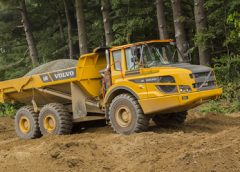Using Technology to Bid Accurately and Stay on Budget.
By Robert Palermo and David Adams
|
|
 |
 |
 |
 |
If you’re a contract miner, you’ve no doubt felt the anxiety that comes with bidding a big, long-term job. Are you bidding it accurately? If you win it, will you be able to stay on time and on budget?
Your level of confidence in answering “yes” to those questions depends on the level of due diligence you put into your estimation process. It could require soil or material testing, contingency plans, analyzing haul routes and more. Regardless of job size, however, it will definitely require that you look at what equipment is needed to accomplish the work and how much it will cost to acquire, operate and maintain that equipment.
Don’t be afraid to turn to a trusted equipment dealer and/or OEM for assistance. Here are just a few ways they can use technology like site simulation and advanced telematics to ensure you are bidding accurately and competitively on your next big job – and staying on budget once you win it.
Determining the Most Efficient Fleet Mix
One of the greatest tools available is software that uses GPS information and other data to allow you to run simulations on the site. An expert from the equipment manufacturer or your dealer can visit the site and conduct an analysis to help you build the ideal combination of haul routes and equipment.
Look for a system that incorporates:
- Jobsite conditions – Information like haul route data, bank density, swell factor, average bucket fill percentage and ground conditions helps determine the right combination of equipment needed.
- Operating hours – You’ll want to calculate working hours per machine, including average shifts per year and average shift duration (minus non-operating delay per shift), and subtracting estimated scheduled maintenance time. This is where information from a managed telematics programs can also come in handy (more on that below).
- Equipment options – Entering equipment models and bucket sizes helps the software program give you an accurate production analysis.
The final production analysis should include data points such as equipment models, bucket sizes, average cycle time, average bucket passes to fill a hauler, estimated average fuel consumption per hour, and, ultimately, a comprehensive fleet analysis outlining fleet production per year in cu. yd. From there, you can go back and run alternative scenarios with different fleet configurations to compare results and find the most efficient mix.
Determining Fleet Operating Costs
While the production analysis provides good baseline information, a more comprehensive estimation should also include depreciation schedules, taxes, insurance, estimated resale value, service plans, tire replacements and maintenance costs, along with monthly financing costs. Equipment manufacturers and dealers can work with you to build the right financing and ongoing support package while incorporating your business’ estimated costs into the total operating cost estimation.
This may seem like a lot to do, but it’s essential information for bid accuracy – particularly when going after a large mining or aggregates job. Going over budget once you’ve landed the job is one of the worst feelings you can experience in the field. That’s why ongoing fleet monitoring on the job is also essential.
How Telematics Keep You on Track
After you win a contract, using telematics is one way to avoid cost overruns and keep track of a project’s budget, considering everything from fuel consumption and machine usage to troubleshooting problems that could spiral into repairs or unplanned downtime. Not all telematics systems are created equal, however. Some send you a bunch of data and leave to you to sort things out. Advanced systems give you actionable information that you can quickly understand and respond to.
Here are three ways to utilize advanced telematics to help you stay on budget.
1. Identify and respond to machine issues more quickly.With an advanced telematics system, data is analyzed for you. Instead of a flood of confusing fault codes, you’ll receive information that includes a probable cause of the issue, a recommended solution, and the potential consequences of not taking action. Some systems also give your dealer this information simultaneously, which prepares them to respond quickly. This can have a major impact on jobsite productivity and staying on budget.
2. Monitor fleet utilization to identify inefficiencies.Another useful way advanced telematics can help you stay on budget is by monitoring machine usage. One example is work-versus-idle percentage. Appropriate idle times can differ significantly by job, so evaluating this data can help address unnecessary costs by spotting machines that are idling away hours and hurting machine resale value. You can also use this data to identify whether you have the correct fleet mix for the job. You may spot underutilized machines that could be reallocated to another job. Identifying these trends ensures that your fleet is as efficient as possible and that no machine or operator is running up project costs unnecessarily.
3. Identify machine misuse. Another helpful feature to look for when evaluating advanced telematics systems is a rundown of potential machine misuse. You can see instances in which an operator is doing something he or she should not, such as high-speed shifts, using the wrong work modes or overuse of differential lock engagement.
Catching these issues can lower costs, increase uptime and identify operator training needs – all of which can help keep project costs down.
Your diligence in producing an accurate bid and staying on top of a project’s progress will undoubtedly pay off, and using the right technology will make those tasks more profitable.
Robert Palermo is articulated hauler product manager and David Adams is connected services sales manager, Volvo Construction Equipment.

